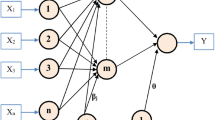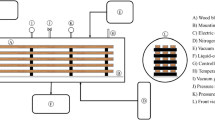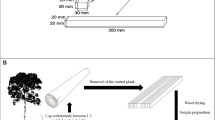Abstract
Surface thermal treatment (STT) can achieve efficient and successful thermal modification on wood surfaces, resulting in a beautiful, natural, uniform darker color and velvety texture. This study aimed to evaluate the effect of STT on White Ash, Yellow Poplar, and Red Oak specimens using a heated press at varying temperatures and times. To enhance the material utilization, reduce the number of experiments, and optimize the process, we employed artificial neural network (ANN) to model the relationship between the provided color, treatment time, and temperature required to attain the desired color. As the ANN model can simulate the process result very fast with a high degree of accuracy (\(R^2\) above 0.96), it allowed us to rule off approximately 95% of the possible combinations, conducting a minimal subset of experiments and thereby saving an enormous amount of time (one experiment takes five hours to be prepared appropriately and more than 20 samples need be tested to get the ideal color). Previous research either investigated how to use ANN or demonstrated other new methodologies for applying thermal treatments. In this study, we propose a novel method to do efficient thermal treatment and train an ANN model which helps eliminate the misdeem experiments. Our ANN model can successfully predict the color change of thermally treated wood. The mean absolute percentage errors (MAPE) from our models were from 10.61 to 10.97% for training and 10.00–10.41% for testing. All obtained determination coefficients (\(R^2\)) were above 0.96. We have demonstrated our method on White Ash, Yellow Poplar, and Red Oak specimens, compared the findings to previous baselines, and exhibited an improvement of over 30% for \(R^2\) in several instances.








Similar content being viewed by others
References
Association IHL (2019) Indiana hardwood strategy. Indiana Hardwood Lumbermens Association. https://www.ihla.org/wp-content/uploads/2019/02/Hardwood-Strategy-Brochure-Indiana-Hardwood-Strategy-full-page.pdf
Ayadi N, Lejeune F, Charrier F, Charrier B, Merlin A (2003) Color stability of heat-treated wood during artificial weathering. Holz Roh- Werkst 61(3):221–226. https://doi.org/10.1007/s00107-003-0389-2
Ayata U, Sahin S, Esteves B, Gurleyen L (2018) Effect of thermal aging on colour and glossiness of uv system varnish-applied laminated parquet layers. BioResources 13(1):861–868
Barcík Š, Gašparík M, Razumov EY (2015) Effect of temperature on the color changes of wood during thermal modification. Cellul Chem Technol 49(9–10):789–98
Bekhta P, Niemz P (2003) Effect of high temperature on the change in color, dimensional stability and mechanical properties of spruce wood. Holzforschung 57(5):539–546. https://doi.org/10.1515/HF.2003.080
Bobadilha GS, Stokes CE, Lopes DJV (2021) Artificial neural networks modelling based on visual analysis of coated cross laminated timber (clt) to predict color change during outdoor exposure. Holzforschung 75(7):646–654. https://doi.org/10.1515/hf-2020-0193
Brito A, Calonego F, Bond B, Severo E et al (2018) Color changes, emc and biological resistance of thermally modified yellow poplar. Wood Fiber Sci 50:439–446
Chen Y, Fan Y, Gao J, Stark NM (2012) The effect of heat treatment on the chemical and color change of black locust (Robinia pseudoacacia) wood flour. BioResources 7(1):1157–1170
Denes L, Lang EM (2013) Photodegradation of heat treated hardwood veneers. J Photochem Photobiol B 118:9–15. https://doi.org/10.1016/j.jphotobiol.2012.09.017
Ding T, Peng W, Li T et al (2017) Mechanism of color change of heat-treated white ash wood by means of ft-ir and xps analyses. J For Eng 2(5):25–30
Esteban LG, Fernández FG, de Palacios P (2009) Moe prediction in Abies pinsapo boiss. timber: application of an artificial neural network using non-destructive testing. Comput Struct 87(21–22):1360–1365. https://doi.org/10.1016/j.compstruc.2009.08.010
Esteves B, Velez Marques A, Domingos I, Pereira H (2008) Heat-induced colour changes of pine (Pinus pinaster) and eucalypt (Eucalyptus globulus) wood. Wood Sci Technol 42(5):369–384. https://doi.org/10.1007/s00226-007-0157-2
Garcia Fernandez F, García Esteban L, Palacios de Palacios P, Navarro Cano N, Conde García M (2008) Prediction of standard particleboard mechanical properties utilizing an artificial neural network and subsequent comparison with a multivariate regression model. Investigación agraria: Sistemas y recursos forestales 17(2):178–187
Gu L, Ding T, Jiang N et al (2019) Development of wood heat treatment research and industrialization. J For Eng 4(4):1–11. https://doi.org/10.13360/j.issn.2096-1359.2019.04.001
Hamzaçebi C, Akay D, Kutay F (2009) Comparison of direct and iterative artificial neural network forecast approaches in multi-periodic time series forecasting. Expert Syst Appl 36(2):3839–3844. https://doi.org/10.1016/j.eswa.2008.02.042
Hill C, Altgen M, Rautkari L (2021) Thermal modification of wood-a review: chemical changes and hygroscopicity. J Mater Sci 56(11):6581–6614. https://doi.org/10.1007/s10853-020-05722-z
Jin T, Kang CW, Lee NH, Kang HY, Matsumura J et al (2011) Changes in the color and physical properties of wood by high temperature heat treatment. J Fac Agric Kyushu Univ 56(1):129–137. https://doi.org/10.5109/19541
Kalogirou SA (2001) Artificial neural networks in renewable energy systems applications: a review. Renew Sustain Energy Rev 5(4):373–401. https://doi.org/10.1016/S1364-0321(01)00006-5
Karlsson O, Torniainen P, Dagbro O, Granlund K, Morén T (2012) Presence of water-soluble compounds in thermally modified wood: carbohydrates and furfurals. BioResources 7(3):3679–3689
Mansfield SD, Iliadis L, Avramidis S (2007) Neural network prediction of bending strength and stiffness in western hemlock (Tsuga heterophylla raf.). Holzforschung 61(6):707–716. https://doi.org/10.1515/HF.2007.115
Meier E (2015) WOOD! Identifying and using hundreds of woods worldwide. https://www.wood-database.com/:The Wood Database
Mitani A, Barboutis I et al (2013) Heat treatment effect on colour changes of beech (fagus sylvatica) wood. Pro ligno 9(4):140–145
Nguyen TT, Van Nguyen TH, Ji X, Yuan B, Trinh HM, Do KTL, Guo M (2019) Prediction of the color change of heat-treated wood during artificial weathering by artificial neural network. Eur J Wood Prod 77(6):1107–1116. https://doi.org/10.1007/s00107-019-01449-0
Pastore TC, Santos KO, Rubim JC (2004) A spectrocolorimetric study on the effect of ultraviolet irradiation of four tropical hardwoods. Bioresour Technol 93(1):37–42. https://doi.org/10.1016/j.biortech.2003.10.035
Ross RJ et al (2010) Wood handbook: wood as an engineering material. USDA Forest Service, Forest Products Laboratory, General Technical Report FPL-GTR-190, 2010: 509 p. 1 v. 190. https://doi.org/10.2737/FPL-GTR-190
Rumelhart DE, Hinton GE, Williams RJ (1986) Learning representations by back-propagating errors. Nature 323(6088):533–536. https://doi.org/10.1038/323533a0
Salca EA, Kobori H, Inagaki T, Kojima Y, Suzuki S (2016) Effect of heat treatment on colour changes of black alder and beech veneers. J Wood Sci 62(4):297–304. https://doi.org/10.1007/s10086-016-1558-3
Samarasinghe S, Kulasiri D, Jamieson T (2007) Neural networks for predicting fracture toughness of individual wood samples. Silva Fennica 41(1):105
Sandberg D, Haller P, Navi P (2013) Thermo-hydro and thermo-hydro-mechanical wood processing: an opportunity for future environmentally friendly wood products. Wood Mater Sci Eng 8(1):64–88. https://doi.org/10.1080/17480272.2012.751935
Sandberg D, Kutnar A, Karlsson O, Jones D (2021) Wood modification technologies: principles, sustainability, and the need for innovation. CRC Press, Boca Raton
Shotwell J, Razzoog M, Koran A (1992) Color stability of long-term soft denture liners. J Prosthet Dent 68(5):836–838. https://doi.org/10.1016/0022-3913(92)90213-T
Tiryaki S, Hamzaçebi C (2014) Predicting modulus of rupture (mor) and modulus of elasticity (moe) of heat treated woods by artificial neural networks. Measurement 49:266–274. https://doi.org/10.1016/j.measurement.2013.12.004
Van Nguyen TH, Nguyen TT, Ji X, Guo M (2018) Predicting color change in wood during heat treatment using an artificial neural network model. BioResources 13(3):6250–6264
Wang D, He H, Liu D (2017) Intelligent optimal control with critic learning for a nonlinear overhead crane system. IEEE Trans Ind Inf 14(7):2932–2940. https://doi.org/10.1109/TII.2017.2771256
Zdravkovic V, Furtula M (2014) Influence of thermal modification on colour of poplar (Populus x Euramericana) rotary cut veneer. Wood Res 59(2):661–670
Zhang G, Patuwo BE, Hu MY (1998) Forecasting with artificial neural networks: the state of the art. Int J Forecast 14(1):35–62. https://doi.org/10.1016/S0169-2070(97)00044-7
Acknowledgements
The authors would like to thank Prof. Biplab Banerjee from Indian Institute of Technology (IIT) Bombay for his valuable insights on the architecture design of the ANN part.
Funding
This research received no external funding.
Author information
Authors and Affiliations
Contributions
Conceptualization and methodology, all authors; experimental work and data analysis, JM algorithm and modeling, DT writing-original draft preparation, JM writing-review and editing, DT and EH. All authors have read and agreed to the published version of the manuscript.
Corresponding author
Ethics declarations
Conflict of interest
The authors declare no conflict of interest.
Additional information
Publisher's Note
Springer Nature remains neutral with regard to jurisdictional claims in published maps and institutional affiliations.
Rights and permissions
Springer Nature or its licensor (e.g. a society or other partner) holds exclusive rights to this article under a publishing agreement with the author(s) or other rightsholder(s); author self-archiving of the accepted manuscript version of this article is solely governed by the terms of such publishing agreement and applicable law.
About this article
Cite this article
Mo, J., Tamboli, D. & Haviarova, E. Prediction of the color change of surface thermally treated wood by artificial neural network. Eur. J. Wood Prod. 81, 1135–1146 (2023). https://doi.org/10.1007/s00107-023-01969-w
Received:
Accepted:
Published:
Issue Date:
DOI: https://doi.org/10.1007/s00107-023-01969-w




